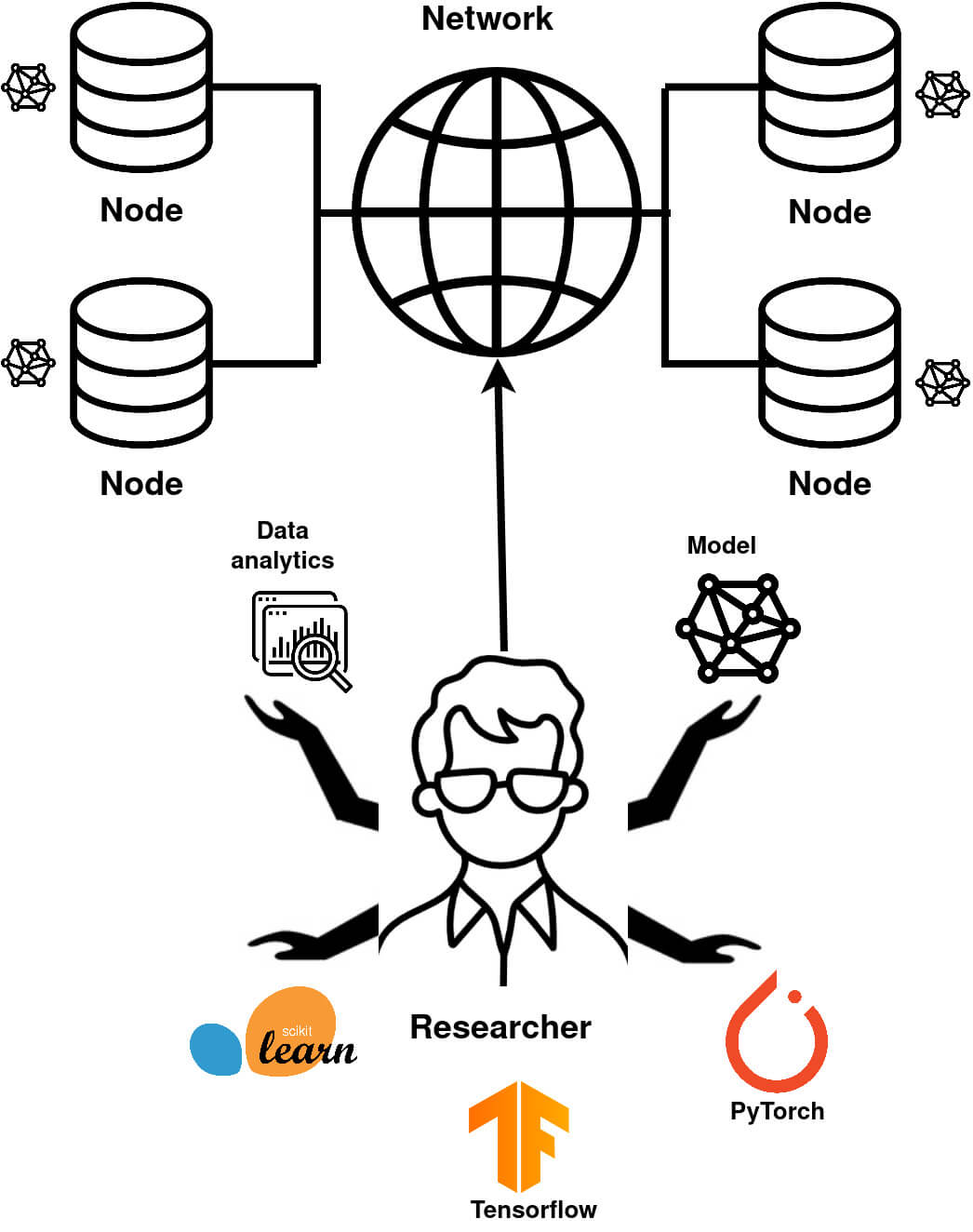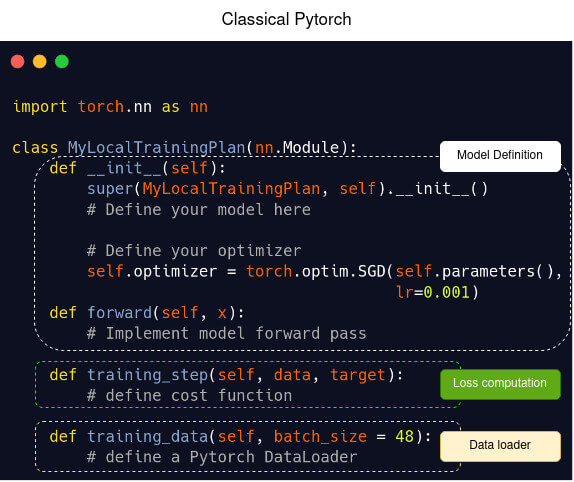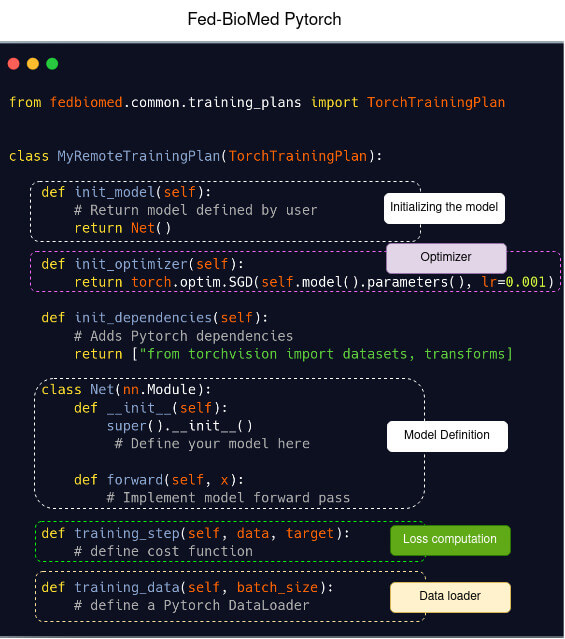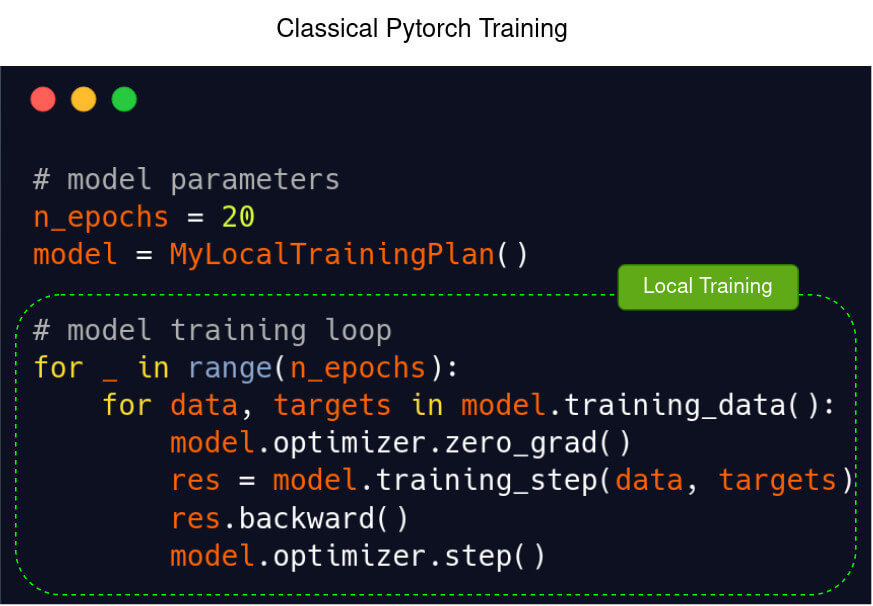Getting Started with Fed-BioMed - Fed-BioMed basic usage example

Network
Network is the Fed-BioMed component that allows communication between the other components (Researcher and Nodes). To launch a Network, open in a terminal (from the Fed-BioMed repository):
./scripts/fedbiomed_run network start
Node
In Federated Learning, a Node is a component on which sensitive data are stored.
To run a node, nothing simpler! From Fed-BioMed repository, enter the following command on a terminal:
./scripts/fedbiomed_run node start
Your Node is now running. Next steps will be to add into the Nodeany datasets, each of them specified with a Tag, allowing any Researcher to search for Nodes with specific dataset to train his/her model on. Further information about how to add data, how to configure your Nodes and deploy it are given Node subsection.
Researcher
1. Launch your Researcher environment
The Researcher is the component used for designing and training Federated models. In a terminal, enter:
source ./scripts/fedbiomed_environment researcher
./scripts/fedbiomed_run researcher start
A jupyter-notebook will pop up, in which you can write your first Federated model.
2. Create and train your Federated Learning model
Models designed in Fed-BioMed using Pytorch are very similar to classic Pytorch models.
Here we provide a code snippet in Pytorch (left) and its equivalent in Fed-BioMed (right). Basically, to define a Pytorch model in Fed-BioMed, create a class as you would do for a Pytorch model, and implement a training_step method for loss computation, a training_data method wrapping a DataLoader for data preprocessing. Finally select an Aggregator and a node selection strategy for Federated model training. Researcher have to specify on which dataset he/she wants to train their data using tags. That's all you have to know!
Template of a model definition in Pytorch (left) and in Fed-BioMed using Pytorch (right)


Template of a model training loop in Pytorch (left) and in Fed-BioMed using Pytorch (right)


Basic Full Example (for jupyter-notebook)
We present here a Multilayer Perceptron model in classic Pytorch and its Federated equivalent in Fed-BioMed.
Multilayer Perceptron in Pytorch: model definition
import os
import torch
import torch.nn as nn
import torch.nn.functional as F
from torchvision import datasets, transforms
from torch.utils.data import Dataset, DataLoader
class MyLocalTrainingPlan(nn.Module):
def __init__(self):
super(MyLocalTrainingPlan, self).__init__()
self.in_features = 28 * 28
self.out_features = 10
self.fc1 = nn.Linear(self.in_features, 50)
self.fc2 = nn.Linear(50, self.out_features)
# optimizer parameters
lr = 0.01
self.optimizer = torch.optim.SGD(self.parameters(), lr=lr)
def forward(self, x):
x = x.reshape(-1, 28*28)
x = self.fc1(x)
x = F.relu(x)
x = self.fc2(x)
output = F.log_softmax(x, dim=1)
return output
def training_step(self, data, target):
output = self.forward(data)
loss = torch.nn.functional.nll_loss(output, target)
return loss
def training_data(self, batch_size = 48):
# Custom torch Dataloader for MNIST data
transform = transforms.Compose([transforms.ToTensor(),
transforms.Normalize((0.1307,), (0.3081,))])
home = os.path.expanduser("~")
path_file = os.path.join(home, 'data')
mnist_dataset = datasets.MNIST(path_file, train=True,
download=True, transform=transform)
data_loader = torch.utils.data.DataLoader(mnist_dataset,
batch_size=batch_size,
shuffle=True)
return data_loader
Multilayer Perceptron in Fed-BioMed with PyTorch: model definition (same example as previous one but transposed to Fed-BioMed Framework)
import torch
import torch.nn as nn
import torch.nn.functional as F
from torchvision import datasets, transforms
from fedbiomed.common.training_plans import TorchTrainingPlan
from fedbiomed.common.data import DataManager
class MyRemoteTrainingPlan(TorchTrainingPlan):
def init_model(self):
return self.Net()
def init_optimizer(self):
return torch.optim.SGD(self.parameters(), lr=0.01)
def init_dependencies(self):
return ["from torchvision import datasets, transforms"]
class Net(nn.Module):
def __init__(self, model_args: dict = {}):
super().__init__()
self.in_features = 28*28
self.out_features = 10
self.fc1 = nn.Linear(self.in_features, 50)
self.fc2 = nn.Linear(50, self.out_features)
def forward(self, x):
x = x.reshape(-1, 28*28)
x = self.fc1(x)
x = F.relu(x)
x = self.fc2(x)
output = F.log_softmax(x, dim=1)
return output
def training_step(self, data, target):
output = self.forward(data)
loss = torch.nn.functional.nll_loss(output, target)
return loss
def training_data(self, batch_size = 48):
# Custom torch Dataloader for MNIST data
transform = transforms.Compose([transforms.ToTensor(),
transforms.Normalize((0.1307,), (0.3081,))])
mnist_dataset = datasets.MNIST(self.dataset_path,
train=True,
download=False,
transform=transform)
return DataManager(mnist_dataset, batch_size=batch_size, shuffle=True)
Multilayer Perceptron in Pytorch: model training loop (same example as previous one but transposed to Fed-BioMed)
# model parameters
n_epochs = 20
model = MyLocalTrainingPlan()
# model training
for _ in range(n_epochs):
for data, targets in model.training_data():
model.optimizer.zero_grad()
res = model.training_step(data, targets)
res.backward()
model.optimizer.step()
Multilayer Perceptron in Fed-BioMed with Pytorch: model training loop
model_args = {}
training_args = {
'batch_size': 48,
'epochs': 20,
'dry_run': False,
}
from fedbiomed.researcher.experiment import Experiment
from fedbiomed.researcher.aggregators.fedavg import FedAverage
tags = ['#MNIST', '#dataset']
rounds = 2
# model training
exp = Experiment(tags=tags,
model_args=model_args,
training_plan_class=MyRemoteTrainingPlan,
training_args=training_args,
round_limit=rounds,
aggregator=FedAverage(),
node_selection_strategy=None)
exp.run()
Going Further
Installation Guide
Detailed steps on how to install Fed-BioMed on your computer.
Tutorials
More tutorials, examples and how-to.
Nodes configuration Guide
Provides an exhaustive overview of Fed-BioMed Nodes.
Researcher configuration Guide
Provides additional info on Fed-BioMed Researcher.


